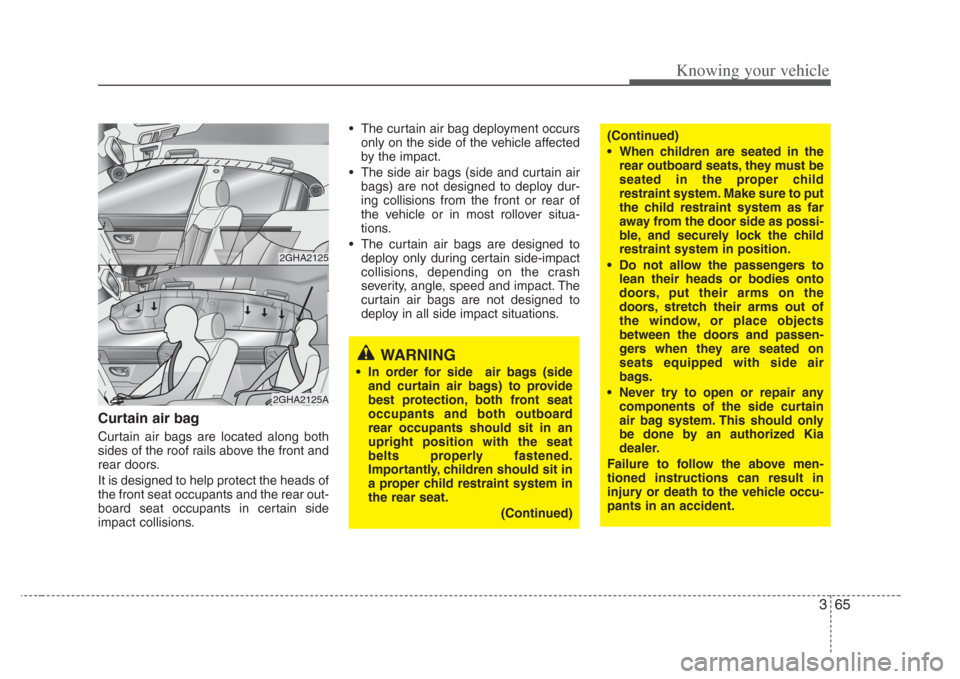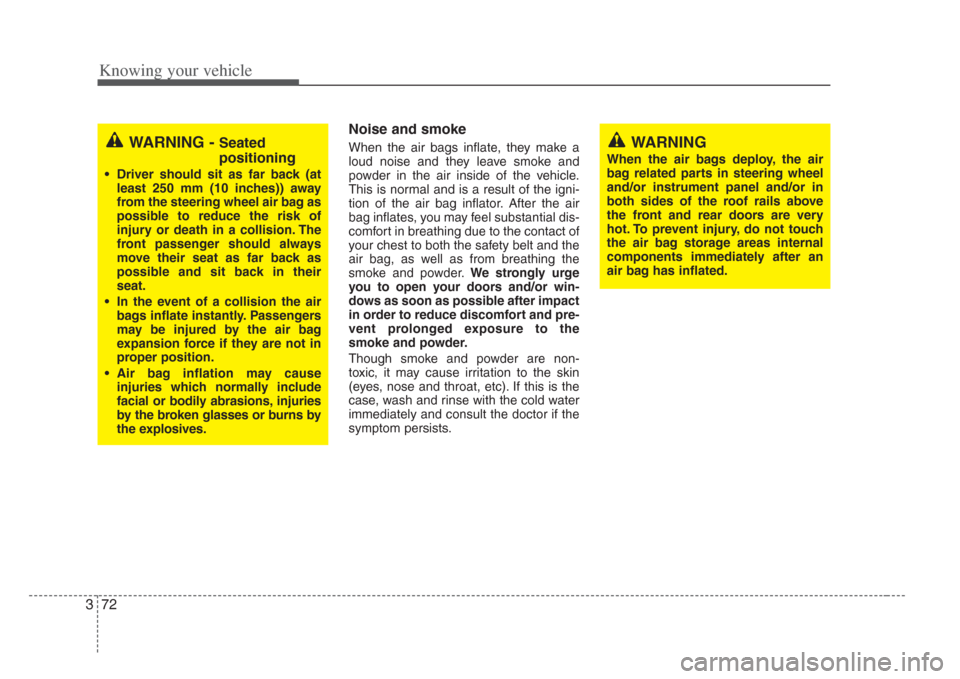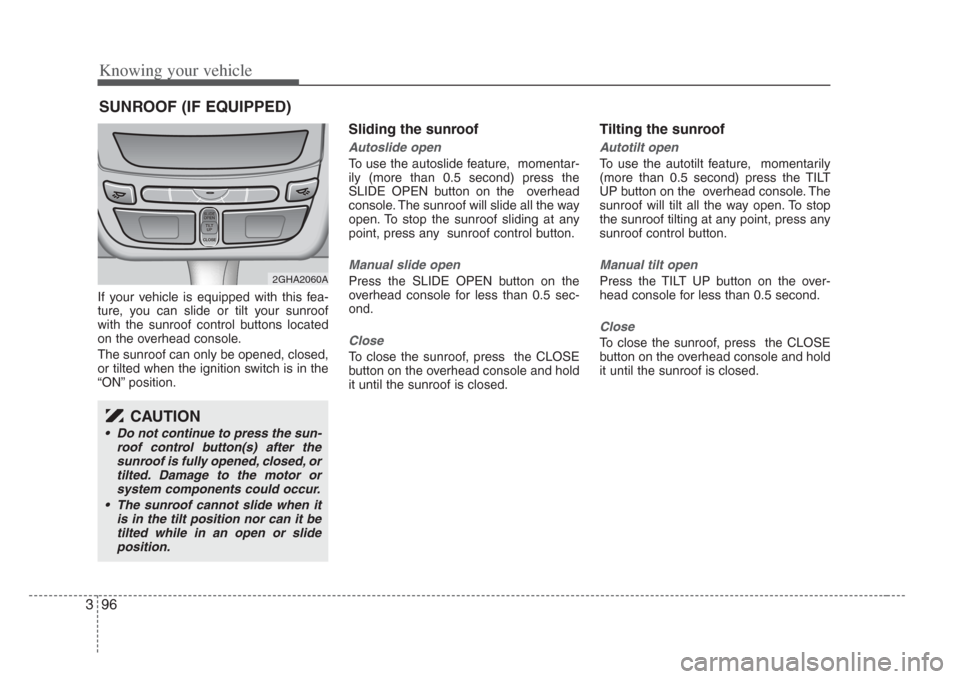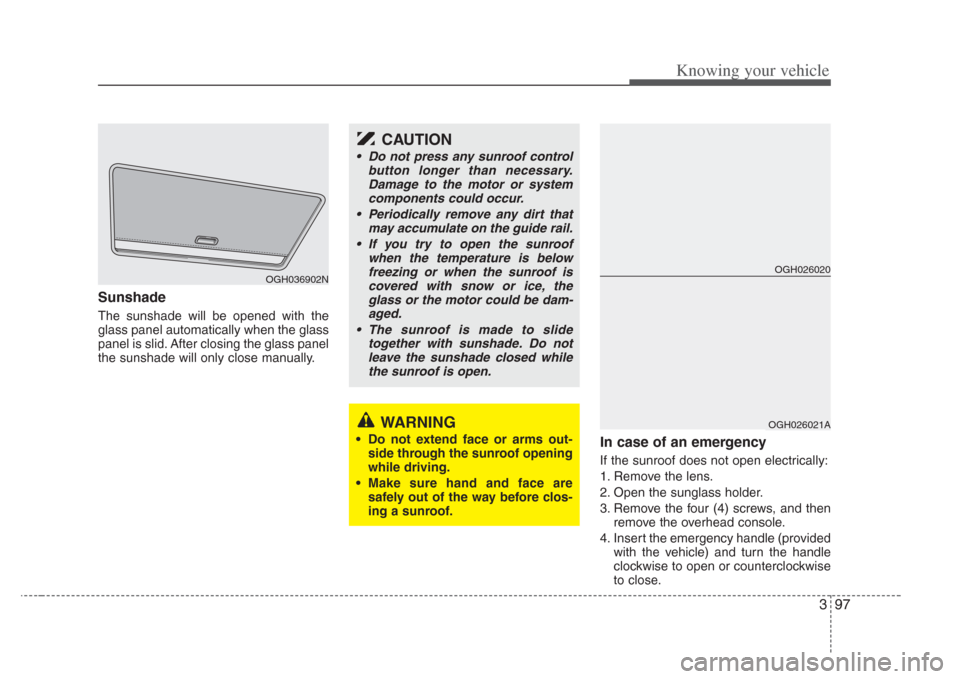2008 KIA Amanti roof
[x] Cancel search: roofPage 11 of 283

3
Keys / 3-2
Remote keyless entry / 3-4
Immobilizer system / 3-7
Door locks / 3-9
Windows / 3-13
Seats / 3-17
Driver position memory system / 3-28
Safety belts / 3-30
Air bags-advanced supplemental restraint system / 3-52
Trunk / 3-76
Hood / 3-80
Fuel filler lid / 3-81
Mirrors / 3-84
Interior lights / 3-88
Storage compartments / 3-89
Interior features / 3-91
Sunroof / 3-96
Antenna / 3-98
Audio remote control / 3-99
Audio systems / 3-100
Knowing your vehicle
Page 75 of 283

365
Knowing your vehicle
Curtain air bag
Curtain air bags are located along both
sides of the roof rails above the front and
rear doors.
It is designed to help protect the heads of
the front seat occupants and the rear out-
board seat occupants in certain side
impact collisions.• The curtain air bag deployment occurs
only on the side of the vehicle affected
by the impact.
• The side air bags (side and curtain air bags) are not designed to deploy dur-
ing collisions from the front or rear of
the vehicle or in most rollover situa-
tions.
• The curtain air bags are designed to deploy only during certain side-impact
collisions, depending on the crash
severity, angle, speed and impact. The
curtain air bags are not designed to
deploy in all side impact situations.
WARNING
• In order for side air bags ( side
and curtain air bag s) to provide
best protection, both front seat
occupants and both outboard
rear occupants should sit in an
upright pos ition with the s eat
belts properly fas tened.
Importantly, children should sit in
a proper child restraint system in
the rear seat.
(Continued)
(Continued)
• When children are seated in the
rear outboard seats, they must be
s eated in the proper child
restraint system. Make sure to put
the child restraint system as far
away from the door side as possi-
ble, and securely lock the child
restraint system in position.
• Do not allow the pa ssengers to
lean their head s or bodies onto
door s, put their arms on the
door s,stretch their arms out of
the window, or place objects
between the door s and passen-
ger s when they are seated on
s eats equipped with s ide air
bags.
• Never try to open or repair any components of the side curtain
air bag system.
This should only
be done by an authorized Kia
dealer.
Failure to follow the above men-
tioned ins tructions can res ult in
injury or death to the vehicle occu-
pants in an accident.
2GHA2125
2GHA2125A
Page 82 of 283

Knowing your vehicle
723
Noise and smoke
When the air bags inflate, they make a
loud noise and they leave smoke and
powder in the air inside of the vehicle.
This is normal and is a result of the igni-
tion of the air bag inflator. After the air
bag inflates, you may feel substantial dis-
comfort in breathing due to the contact of
your chest to both the safety belt and the
air bag, as well as from breathing the
smoke and powder.We strongly urge
you to open your door s and/or win-
dows a s soon as possible after impact
in order to reduce discomfort and pre-
vent prolonged expos ure to the
smoke and powder.
Though smoke and powder are non-
toxic, it may cause irritation to the skin
(eyes, nose and throat, etc). If this is the
case, wash and rinse with the cold water
immediately and consult the doctor if the
symptom persists.WARNING - Seated
positioning
• Driver should sit as far back (at
least 250 mm (10 inches)) away
from the steering wheel air bag a s
possible to reduce the ris k of
injury or death in a collision. The
front passenger should always
move their seat as far back as
possible and s it back in their
seat.
• In the event of a collision the air bags inflate instantly. Passenger s
may be injured by the air bag
expansion force if they are not in
proper position.
• Air bag inflation may caus e
injuries which normally include
facial or bodily abras ions, injuries
by the broken glasse s or burns by
the explos ives.
WARNING
When the air bag s deploy, the air
bag related part s in steering wheel
and/or instrument panel and/or in
both sides of the roof rails above
the front and rear door s are very
hot. To prevent injury, do not touch
the air bag storage areas internal
components immediately after an
air bag has inflated.
Page 84 of 283

Knowing your vehicle
743
Air bag (Supplemental Restraint
System) service
Your Supplemental Restraint System is
virtually maintenance-free. There are no
parts which you can service.
You must have the system serviced
under the following circumstances:
• If an air bag ever inflates, the air bag
must be replaced. Do not try to remove
or discard the air bag by yourself. This
must be done by an authorized Kia
dealer.
• If the air bag warning indicator light alerts you to a problem, have the air
bag system checked as soon as possi-
ble. Otherwise, your air bag system
may be ineffective.
When repairing or scrapping thevehicles
• Repairing steering wheel, instrument panel, center console or roofs, or
installing car audio around center con-
sole or painting front metal sheet could
disable the air bag system. Have them
checked by an authorized Kia dealer.
• When leaving the vehicle at an author- ized Kia dealer, inform the facility that
the vehicle is equipped with an air bag
system, and leave the owner’s manual
in the vehicle.
• Since the air bag system contains explosive chemical substances, con-
tact an authorized Kia dealer when
scrapping the vehicle.
WARNING- No mainte-
nance or repair
• Do not modify your s teering
wheel, seat or any other part of
the Supplemental Res traint
System. Modification could make
the system inoperable.
• Do not work on the system’ s com-
ponents or wiring. This could
cause the air bags to inflate inad-
vertently, possibly seriously injur-
ing someone. Working on the sys-
tem could al so disable the sys-
tem so that the air bags would not
deploy in a collision.
• Any work on the SRS system, such as removing, ins talling,
repairing, or any work on the
s teering wheel mus t be per-
formed by a qualified Kia techni-
cian. Improper handling of the air
bag system may result in serious
per sonal injury or death.
CAUTION - No modifica-
tion
Do not modify any part of the air
bag system. Modification could
make the air bag system ineffective
or could caus e unnecessary
deployment.
Page 106 of 283

Knowing your vehicle
963
If your vehicle is equipped with this fea-
ture, you can slide or tilt your sunroof
with the sunroof control buttons located
on the overhead console.
The sunroof can only be opened, closed,
or tilted when the ignition switch is in the
“ON” position.
Sliding the sunroof
Autoslide open
To use the autoslide feature, momentar-
ily (more than 0.5 second) press the
SLIDE OPEN button on the overhead
console. The sunroof will slide all the way
open. To stop the sunroof sliding at any
point, press any sunroof control button.
Manual slide open
Press the SLIDE OPEN button on the
overhead console for less than 0.5 sec-
ond.
Close
To close the sunroof, press the CLOSE
button on the overhead console and hold
it until the sunroof is closed.
Tilting the sunroof
Autotilt open
To use the autotilt feature, momentarily
(more than 0.5 second) press the TILT
UP button on the overhead console. The
sunroof will tilt all the way open. To stop
the sunroof tilting at any point, press any
sunroof control button.
Manual tilt open
Press the TILT UP button on the over-
head console for less than 0.5 second.
Close
To close the sunroof, press the CLOSE
button on the overhead console and hold
it until the sunroof is closed.
SUNROOF (IF EQUIPPED)
SLIDESLIDEOPENOPENTILT
UPUPCLOSECLOSE
SLIDESLIDEOPENOPENTILT
UPUPCLOSECLOSE
2GHA2060A
CAUTION
• Do not continue to pre ss the sun-
roof control button(s) after the sunroof is fully opened, clo sed, or
tilted. Damage to the motor or system components could occur.
• The sunroof cannot slide when it
is in the tilt position nor can it be tilted while in an open or slide
position.
Page 107 of 283

397
Knowing your vehicle
Sunshade
The sunshade will be opened with the
glass panel automatically when the glass
panel is slid. After closing the glass panel
the sunshade will only close manually.
In case of an emergency
If the sunroof does not open electrically:
1. Remove the lens.
2. Open the sunglass holder.
3. Remove the four (4) screws, and thenremove the overhead console.
4. Insert the emergency handle (provided with the vehicle) and turn the handle
clockwise to open or counterclockwise
to close.
OGH036902N
WARNING
• Do not extend face or arms out-side through the sunroof opening
while driving.
• Make sure hand and face are
safely out of the way before clo s-
ing a sunroof.
CAUTION
• Do not press any sunroof control button longer than necessary.Damage to the motor or system
components could occur.
• Periodically remove any dirt that may accumulate on the guide rail.
• If you try to open the sunroof when the temperature is belowfreezing or when the sunroof iscovered with s now or ice, the
glass or the motor could be dam- aged.
• The sunroof is made to s lide
together with sunshade. Do not leave the sunshade closed while the sunroof is open.
OGH026020
OGH026021A
Page 108 of 283

Knowing your vehicle
983
Resetting the sunroof
Whenever the vehicle battery is discon-
nected or discharged, or you use the
emergency handle to operate the sun-
roof, you have to reset your sunroof sys-
tem as follows:
1. Turn the ignition key to the ON posi-tion.
2. According to the position of the sun- roof, do as follows.
1) in case that the sunroof has closedcompletely or been tilted
: Press the TILT UP button for 1 second.
2) in case that the sunroof has slide- opened
: Press and hold the CLOSE button for more than 5 seconds until the
sunroof has closed completely.
And then press the TILT UP but-
ton for 1 second
3. Then, release it.
4. Press and hold the TILT UP button once again until the sunroof has
returned to the original position of
TILT UP after it is raised a little higher
than the maximum TILT UP position.
When this is complete, the sunroof sys-
tem is reset.
Glass antenna (if equipped)
When the radio power switch is turned on
while the ignition key is in either the “ON”
or “ACC” position, your car will receive
both AM and FM broadcast signals
through the antenna in the rear window
glass.
ANTENNA
OGH036399N
CAUTION
• Do not clean the in side of the rear
window gla ss with a cleaner or
s craper to remove the foreign
deposits a s this may cause dam-
age to the antenna element s.
• Avoid adding metallic coating such as Ni, Cd, and so on. Thesecan disturb receiving AM and FMbroadcast signals.
Page 222 of 283

69
In case of an emergency
Description Fus e rating Protected component
1 FUEL PUMP 20A Fuel pump
2 H/LP (LO-LH) 15A Headlight (low-left)
3 ABS 10A Anti-lock brake system
4 IGN COIL 15A Ignition coil
5 A/CON COMP 10A Air-conditioner compressor
6 ATM 20A Automatic transaxle control relay
7 MAIN 20A Engine control unit relay
8 O2 SNSR 15A Oxygen sensor
9 EGR 15A
Power train control system sensors
10 HORN 15A Horn
11 TAIL 20A Tail light
12 SUNROOF 20A Sun roof
13 P/SEAT (RH) 20A Power seat (right)
14 FOG LP (FR) 15A Fog light (front)
15 H/LP (HI) 15A Headlight (high)
16 SPARE 30A spare fuse
17 SPARE 20A spare fuse
18 SPARE 15A spare fuse
19 SPARE 10A spare fuse
20 P/SEAT (LH) 30A Power seat (left)
21 AMP 20A Radio amplifier
22 DRL* 15A Daytime running light
Engine compartment
Description Fus e rating Protected component
23 H/LP (LO-RH) 15A Headlight (low beam-right)
24 I/P B+ 30A All electrical system
25 ECU 10A Engine control unit
26 INJECTOR 10A Injector
27 ECS * 15A Electronic control suspension
BLOWER 40A Blower motor
IGN 1 30A Ignition switch
ABS 2 30A Anti-lock brake system
ABS 1 30A Anti-lock brake system
IGN 2 30A Ignition switch
S/WARM 30A Seat warmer
H/LP (LO-LH) - Headlight relay (low beam-left)
FUEL PUMP - Fuel pump relay
HORN - Horn relay
START - Start motor relay
A/CON - Air conditioner relay
H/LP (HI) - Headlight relay (high beam)
FOG LP (FR) - Fog light relay (front)
TAIL LP - Taillight relay
WIPER - Wiper relay
BATT 60A Alternator, Battery
ALT 150A Alternator
COOLING 60A Cooling fan
* : if equipped